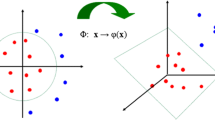Abstract
Spam exists in several domains including SMS and Emails which are usually targeted by spammers to steal personal information, money, data, etc. There are several models exist for SMS and Email spam detection out of which supervised learning-based model is mostly efficient. However, the comprehensive study for spam detection with consideration to multiple domains simultaneously, is missing. In this paper an experimental evaluation on the effect of using feature selection techniques in the domain of SMS and Email spam detection is conducted. Parameters such as ROC and Train/Test time along with common parameters are used to evaluate performance of spam detection models. The experimentation results shows that the choice of feature selection technique has profound effect on the performance of the spam detection model and can be seen in the result generated using different evaluation measures out of which some are not used in the both domains previously.
Access this chapter
Tax calculation will be finalised at checkout
Purchases are for personal use only
Similar content being viewed by others
References
Sethi, P., Bhandari, V., & Kohli, B. (2017). SMS spam detection and comparison of various machine learning algorithms. In 2017 International Conference on Computing and Communication Technologies for Smart Nation (IC3TSN) (pp. 28–31). https://doi.org/10.1109/IC3TSN.2017.8284445
Gadde, S., Lakshmanarao, A., & Satyanarayana, S. (2021). SMS spam detection using machine learning and deep learning techniques. In 2021 7th International Conference on Advanced Computing and Communication Systems (ICACCS) (p. 358362).
Navaney, P., Dubey, G., & Rana, A. (2018). SMS spam filtering using supervised machine learning algorithms. In 2018 8th international conference on cloud computing, data science & engineering (confluence) (pp. 43–48). https://doi.org/10.1109/CONFLUENCE.2018.8442564
Tang, S., Mi, X., Li, Y., Wang, X., & Chen, K. (2022). Clues in tweets: Twitter-guided discovery and analysis of SMS spam. arXiv preprint arXiv:2204.01233. 2022 Apr 4.
ElBakrawy, L. M. (2019). Hybrid particle swarm optimization and Pegasos algorithm for spam Email detection. https://doi.org/10.25728/assa.2019.19.3.751
Jain, T., Garg, P., Chalil, N., Sinha, A., Verma, V. K., & Gupta, R. (2022). SMS spam classification using machine learning techniques. In 2022 12th international conference on cloud computing, data science & engineering (confluence) (pp. 273–279). https://doi.org/10.1109/Confluence52989.2022.9734128
Annareddy, S., & Tammina, S. (2019). A comparative study of deep learning methods for spam detection. In 2019 third international conference on I-SMAC (IoT in Social, Mobile, Analytics and Cloud) (I-SMAC) (pp. 66–72).
Agarwal, K., & Kumar, T. (2018). Email spam detection using integrated approach of Naïve Bayes and particle swarm optimization. Second International Conference on Intelligent Computing and Control Systems (ICICCS), 2018, 685–690. https://doi.org/10.1109/ICCONS.2018.8662957.
Iyengar, A., Kalpana, G., Kalyankumar, S., & GunaNandhini, S. (2017). Integrated SPAM detection for multilingual emails. International Conference on Information Communication and Embedded Systems (ICICES), 2017, 1–4. https://doi.org/10.1109/ICICES.2017.8070784.
Ponmalar, A., Rajkumar, K., Hariharan, U., Kalaiselvi, V. K. G., & Deeba, S. (2021). Analysis of spam detection using integration of logistic regression and PSO algorithm. In 2021 4th International Conference on Computing and Communications Technologies (ICCCT) (pp. 396–402). https://doi.org/10.1109/ICCCT53315.2021.9711903
Raza, M., Jayasinghe, N. D., & Muslam, M. M. A. (2021). A comprehensive review on email spam classification using machine learning algorithms. International Conference on Information Networking (ICOIN), 2021, 327–332.
GuangJun, L., Nazir, S., Khan, H. U., & Ul Haq, A. (2020). Spam detection approach for secure mobile messgae communication using machine learning algorithms. In Hindawi, security and communication netwroks (Vol. 2020, Article id: 8873639)
Maloof, M. A. (2002). On machine learning, ROC analysis, and statistical tests of significance. In 2002 international conference on pattern recognition (Vol. 2, pp. 204–207). https://doi.org/10.1109/ICPR.2002.1048273
Nandhini, S., & Marseline, K. S. (2020). Performance evaluation of machine learning algorithms for Email spam detection. In 2020 international conference on Emerging Trends in Information Technology and Engineering (ic-ETITE), Vellore, India (pp. 1–4). https://doi.org/10.1109/icETITE47903.2020.312
GuangJun, L., Nazir, S., Khan, H. U., & Ul Haq, A. (2020). Spam detection approach for secure mobile messgae communication using machine learning algorithms. In Hindawi, security and communication netwroks (Vol. 2020, Article id: 8873639)
Sravya, G. S., Pradeepini, G., & Vaddeswaram. (2020). Mobile Sms spam filter techniques using machine learning techniques. International Journal of Scientific & Technology Research, 9(03).
Markova, E., Bajtoš, T., Sokol, P., & Mzéšová, T. (2019). Classification of malicious emails. In 2019 IEEE 15th international scientific conference on informatics, Poprad, Slovakia (pp. 000279–000284). https://doi.org/10.1109/Informatics47936.2019.9119329
Ismailov, A., Jalil, M. M. A., Abdullah, Z., & Rahim, N. H. A. (2016). A comparative study of stemming algorithms for use with the Uzbek language. In 2016 3rd International Conference on Computer and Information Sciences (ICCOINS) (pp. 7–12).https://doi.org/10.1109/ICCOINS.2016.7783180
Acknowledgements
Author’s are thankful to Shri G. S. Institute of Technology and Science, Indore for providing all facilities and necessary support to carry out the research work.
Author information
Authors and Affiliations
Corresponding author
Editor information
Editors and Affiliations
Rights and permissions
Copyright information
© 2023 The Author(s), under exclusive license to Springer Nature Singapore Pte Ltd.
About this paper
Cite this paper
Chaturvedi, S.A., Purohit, L. (2023). Feature Selection-Based Spam Detection System in SMS and Email Domain. In: Shakya, S., Du, KL., Ntalianis, K. (eds) Sentiment Analysis and Deep Learning. Advances in Intelligent Systems and Computing, vol 1432. Springer, Singapore. https://doi.org/10.1007/978-981-19-5443-6_4
Download citation
DOI: https://doi.org/10.1007/978-981-19-5443-6_4
Published:
Publisher Name: Springer, Singapore
Print ISBN: 978-981-19-5442-9
Online ISBN: 978-981-19-5443-6
eBook Packages: Intelligent Technologies and RoboticsIntelligent Technologies and Robotics (R0)




